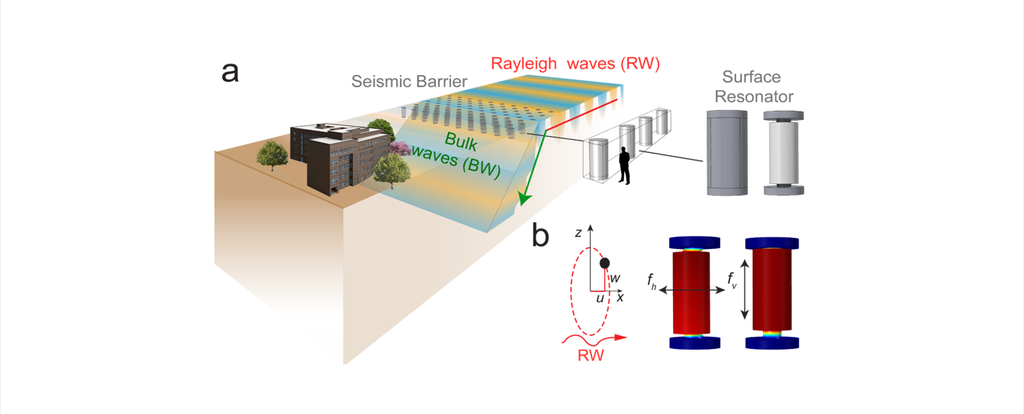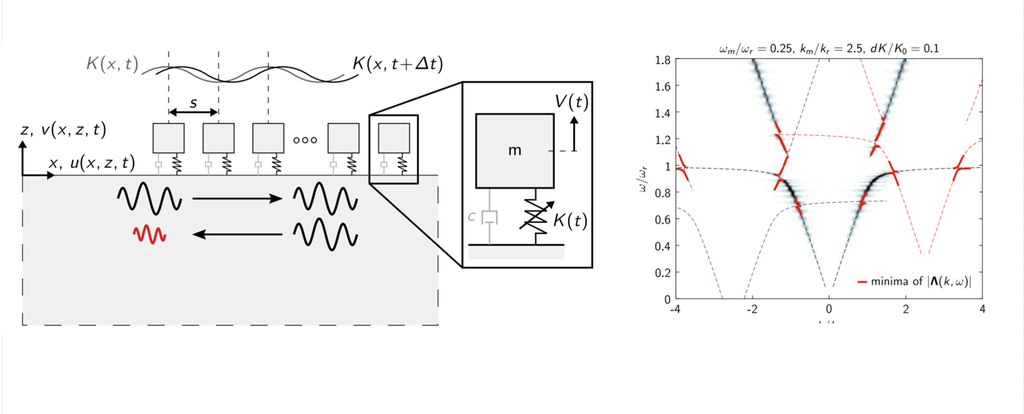Metamaterials for wave propagation control
Metabarriers for ground-borne vibration control
In recent years, resonant metamaterials have been proposed to reflect or redirect elastic waves at different length scales, ranging from thermal to ground-borne vibrations. In the latter context, where elastic energy is mostly carried by surface waves, reflection and redirection of waves might lead to harming surrounding regions. Our research group has thus proposed a "metabarrier" able to convert surface Rayleigh waves into shear bulk waves that propagate away from the soil surface. The metabarrier is realized by burying sub-wavelength resonant structures under the soil surface.
Each resonant structure consists of a cylindrical mass suspended by elastomeric springs within a concrete case and can be tuned to the resonance frequency of interest.
To analyze the performance of this isolation system, we have developed analytical models based on effective medium theory able to capture the mode conversion mechanism. The model has been used to guide the design of metabarriers for varying soil conditions, namely homogenous, layered and satured porous soils and has been validated using finite-element simulations. Additionally, we have investigated the shielding performance of the metabarrier in scaled laboratory tests and we are currently working towards the realization of a 1:10 scaled prototype in the field.
References
- A. Palermo, S. Krödel, A. Marzani, C. Daraio, Engineered metabarrier as shield from seismic surface waves. Scientific Reports. (2016)
- A. Palermo, S. Krödel, K.H. Matlack, R. Zaccherini, V.K. Dertimanis, E.N. Chatzi, A. Marzani, and C. Daraio, Hybridization of guided surface acoustic modes in unconsolidated granular media by a resonant metasurface. Physical Review Applied, 9 (2018), p.054026.
- F. Zeighami, A. Palermo, A. Marzani, Rayleigh waves in locally resonant metamaterials. International Journal of Mechanical Sciences (2020), p.106250.
- X. Pu, A. Palermo, Z. Cheng, Z. Shi, A. Marzani, Seismic metasurfaces on porous layered media: Surface resonators and fluid-solid interaction effects on the propagation of Rayleigh waves, International Journal of Engineering Science (2020), 154, 103347.
Metasurfaces for surface wave manipulation
The study of surface waves in solid materials is a classical topic of elastodynamics which still attracts the interest of numerous researchers from different disciplines such as geophysics, geotechnical engineering, solid-state physics, material science, electronic engineering, among the others. The interest arises from the multiple methodologies/technologies which utilize surface waves, as non-invasive testing for material characterization, or filters, delay lines and transformers for electronic devices.
Recently, the development of a new class of artificial composites, named elastic metamaterials, has opened unprecedented possibilities in the control of elastic waves. Within the broad class of metamaterials, a “metasurface” consists of a periodic or random arrangement of resonant pillars/oscillators or resonant inclusions at the free surface of an elastic media, specifically designed to control surface waves.
In this context, our group is working towards the development of analytical models to guide the design of metasurfaces for:
-(i) waveguiding and lensing of elastic surface waves;
-(ii) tunable/directional filtering of elastic surface waves;
-(iii) uni-directional propagation of elastic surface waves;
We expect these models to pave the way towards the realization of surface wave devices for lab-on-chip technologies and microfluidics applications.
References
- A. Palermo, A. Marzani, Control of Love waves by resonant metasurfaces. Scientific Reports. (2018)
- A. Palermo, P. Celli, B. Yousefzadeh, C. Daraio, A. Marzani,Surface wave non-reciprocity via time-modulated metamaterials, Journal of the Mechanics and Physics of Solids (2020) 145, 104181
- F. Zeighami, A. Palermo, A. Marzani,Inertial amplified resonators for tunable metasurfaces, Meccanica (2019), 1-13.




